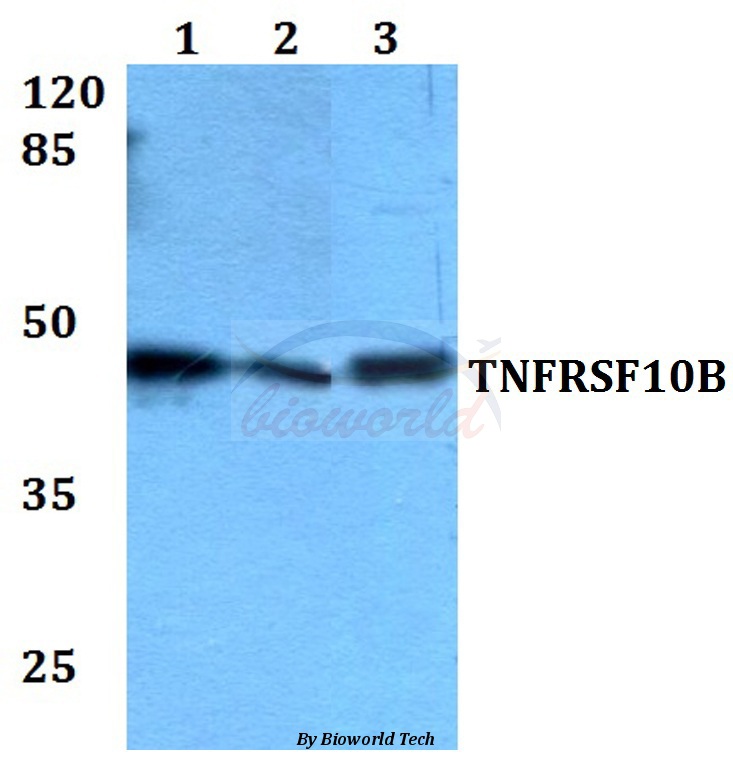anti-CD262 / TRAIL R2 antibody [DR5-01-1] (FITC)
ARG53806
ApplicationsFlow Cytometry
Product group Antibodies
ReactivityHuman
TargetTNFRSF10B
Overview
- SupplierArigo Biolaboratories
- Product Nameanti-CD262 / TRAIL R2 antibody [DR5-01-1] (FITC)
- Delivery Days Customer23
- ApplicationsFlow Cytometry
- CertificationResearch Use Only
- ClonalityMonoclonal
- Clone IDDR5-01-1
- Concentration0.1 mg/ml
- ConjugateFITC
- Gene ID8795
- Target nameTNFRSF10B
- Target descriptionTNF receptor superfamily member 10b
- Target synonymsCD262, DR5, KILLER, KILLER/DR5, TRAIL-R2, TRAILR2, TRICK2, TRICK2A, TRICK2B, TRICKB, ZTNFR9, tumor necrosis factor receptor superfamily member 10B, Fas-like protein, TNF-related apoptosis-inducing ligand receptor 2, apoptosis inducing protein TRICK2A/2B, apoptosis inducing receptor TRAIL-R2, cytotoxic TRAIL receptor-2, death domain containing receptor for TRAIL/Apo-2L, death receptor 5, p53-regulated DNA damage-inducible cell death receptor(killer), tumor necrosis factor receptor superfamily, member 10b, tumor necrosis factor receptor-like protein ZTNFR9
- HostMouse
- IsotypeIgG1
- Scientific DescriptionTRAIL-R2 (CD262, DR5) is one of two TNF superfamily member intracellular death domain containing receptors for TRAIL (APO2L). Apoptosis, or programmed cell death, occurs during normal cellular differentiation and development of multicellular organisms. Apoptosis is induced by certain cytokines including tumor necrosis factor (TNF) and Fas ligand in the TNF family through their death domain containing receptors, TNF receptor 1 (TNFR1) and Fas, respectively. Another member in the TNF family has been identified and designated TRAIL (for TNF related apoptosis inducing ligand) and Apo2L (for Apo2 ligand). Receptors for TRAIL include two death domain containing receptors, DR4 and DR5, as well as two decoy receptors, DcR1 and DcR2, lacking the intracellular signaling death domain. DcR1 (also called TRID), like the related death receptors DR4 and DR5, contains two extracellular cysteine rich domains. However, DcR1 contains no intracellular death domain and is thus incapable of signaling apoptosis. It has been suggested DcR1 is responsible for TRAIL resistance in normal human tissues including heart, placenta, lung, liver, kidney, spleen, and bone marrow. DR5 is a member of the TNF receptor superfamily, and contains an intracellular death domain. This receptor can be activated by tumor necrosis factor related apoptosis inducing ligand (TNFSF10/TRAIL/APO2L), and transduces apoptosis signal. Studies with FADD deficient mice suggested that FADD, a death domain containing adaptor protein, is required for the apoptosis mediated by this protein.
- ReactivityHuman
- Storage Instruction2°C to 8°C
- UNSPSC12352203



![FACS analysis of BJAB cells using GTX42180 DR5 antibody [DJR2-4].](https://www.genetex.com/upload/website/prouct_img/normal/GTX42180/GTX42180_3584_FACS_w_23060820_739.webp)


